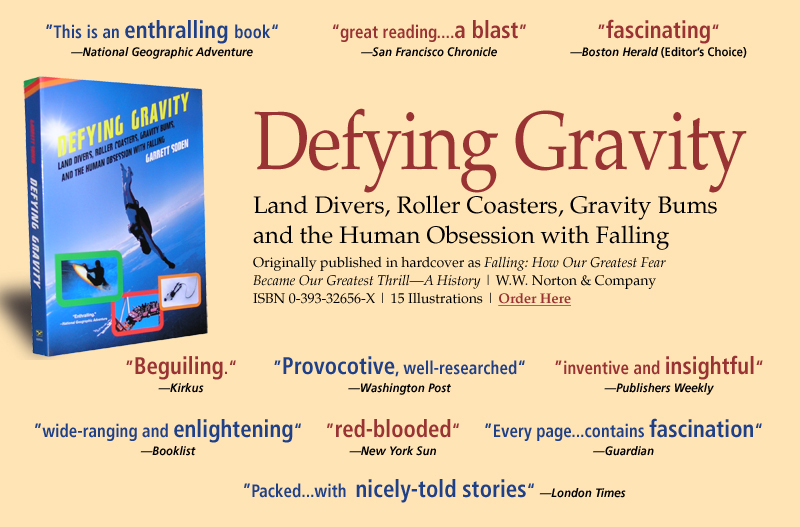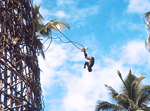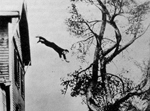 |
|
|||||||||||
| FOR MILLENIA, falling was a sensation so terrifying that the ancients used it as a metaphor for damnation. Today, this same sensation is so prized that millions crave its intense rush - and get it by snowboarding off a half-pipe, careening down a two-hundred-foot thrill-ride drop, or experiencing the rush vicariously by tuning in to one of the most stunningly successful TV franchises of the last decade: ESPN's X Games. By now it's clear that there is a revolution going on in popular sports and recreation. But how did it happen? That's the story that Defying Gravity tells.
Also included are mountaineers such as Matterhorn conqueror Edward Whymper, who saw four of his ropemates plunge four-thousand feet to their death when the rope broke; and 1920s Hollywood stuntmen who'd try "any foolish stunt my psychopaths in the writing room could think up," as director Mack Sennett put it. Riveting as these portraits are, as the story of falling unfolds, one surprising turn after another reveals much more. Cognitive linguists offer insights as to why the metaphor of falling runs so deeply in myth and religion (why, for example, many Christians believe Satan was an angel who fell from heaven, even though that story isn't in the Bible). Psychologists explain that a love of falling (and other sensation-seeking antics) speaks volumes about one's personality (it's no coincidence that so many extreme athletes like drugs and hate authority). And anthropologists divulge that over the sixty-five million years of primate evolution that led to humans, the sense of gravity was perhaps the single greatest influence on the shape of our bodies and brains - and may have even given birth to human consciousness itself. THE STORY Defying Gravity presents its themes in an introduction that tells one of the extraordinary tales typical of gravity recreation; in this case, how bungee jumping was invented. All the usual suspects are here.
Themes introduced here become familiar in the ensuing chapters: that scientific efforts to explore a new gravity activity are often eclipsed by its popularity as a spectacle; that advances are usually made not by sober scientists but by showmen; that something about gravity play creates hard opinions, so that some see its pioneers as heroes while others curse them as irresponsible exploiters of the worst in human nature. PART 1: DAREDEVILS, HEROES, AND MADMEN
But as Part 1 draws to a close, there's trouble in the world of gravity play. Moralizers condemn Léotard and Blondin; Steven Brodie, lionized for jumping from the Brooklyn Bridge, turns out to be a fraud; in Switzerland, "extremist" climbers attempting the Eiger perish, bringing heaps of vitriol on mountaineers. Worse, the tall structures rising in the cities - such as the Eiffel Tower and Golden Gate Bridge - become magnets for those determined to fly from the railings into eternity. Even the Golden Age of Roller Coasters turns to lead, killed by the onslaught of the Great Depression. Finally, in a chapter entitled "The Fall of the Noble Daredevil," we see the image of the gravity hero destroyed, ruined by a parade of lunatics at Niagara who kill themselves with alarming frequency. PART 2: REBELS, CULTS, AND PRIMATES
By the middle of the century, new ways to excite our sense of gravity appear, driven now by an emerging youth culture. We see surfing, the grandfather of extreme sports, brought to California by two strapping Hawaiians, George Freeth and Duke Kahanamoku. After surfing roars into the mainstream on the heels of the movie Gidget, we learn how Santa Monica street kids, trespassing in drought-emptied swimming pools, morph sidewalk surfing into the stunning aerial dance known as vert skateboarding. In Yosemite, we follow drug-fueled climbing cults as they scurry up sheer cliffs on toes and fingertips, conquering routes thought impossible just years before.
The final chapter reports on the latest in falling: the monstrous new thrill rides such as Magic Mountain's X, which flips you as you fall; the tow-in technique that now launches surfers down the face of eighty-foot waves, and more. It also makes a prediction: that in the near future, home motion simulators, with huge screens and teetering seats, will bring the sensation of falling directly into our living rooms.
|
marketing | books | articles | biography | contact | home
Copyright © 2006 Garrett Soden




